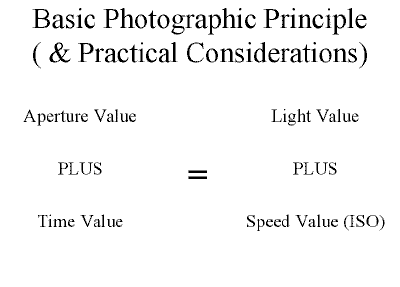Depth of Field: This is determined by the length of the lens. Depth of field refers to the distance between the closest object in an image and the farthest object in an image and their sharpness. Portraits usually have a very shallow depth of field, while landscape and architectural photographs typically have a very wide depth of field.
Open diaphragm -> Smaller depth of film
Closed diaphragm -> Larger depth of film
Closed diaphragm -> Less light
Good Picture = Right combination
Shutter Speed: This determines how much light goes into the camera. It determines the length of time light reaches the camera's sensor or film. The shutter speed is indicated in terms of fractions of a second. A shutter speed of 1/125 means the shutter curtain opens and closes in 1/125th of a second. A shutter speed of one means the shutter opens and closes in one second. The minimum is 1/30 and the maximum is 1/1000. A fast speed = less light. Wide angle = depth of field increase.

ISO: Sensor sensitivity. How the film reacts to light. Low ISO = less light.
ISO 100 or 200 film speeds are best for bright lighting conditions and outdoor photography.
ISO 400 film speed is a great all-purpose film that can be used for most situations.
Fast speed film will result in the grainiest photographs but is great to use when shooting fast-moving subjects in low light conditions.
Low speed = more light
High speed = less light
High sensitivity = more light
Low sensitivity = less light
High ISO (1600+) = grainy
Light Meter: Measures how much light is coming in the camera.
The measurement of color temperature is in Kelvin degrees.
Fill flash or "fill-in flash" describes flash used to supplement ambient light in order to illuminate a subject close to the camera that would otherwise be in shade relative to the rest of the scene.
No comments:
Post a Comment